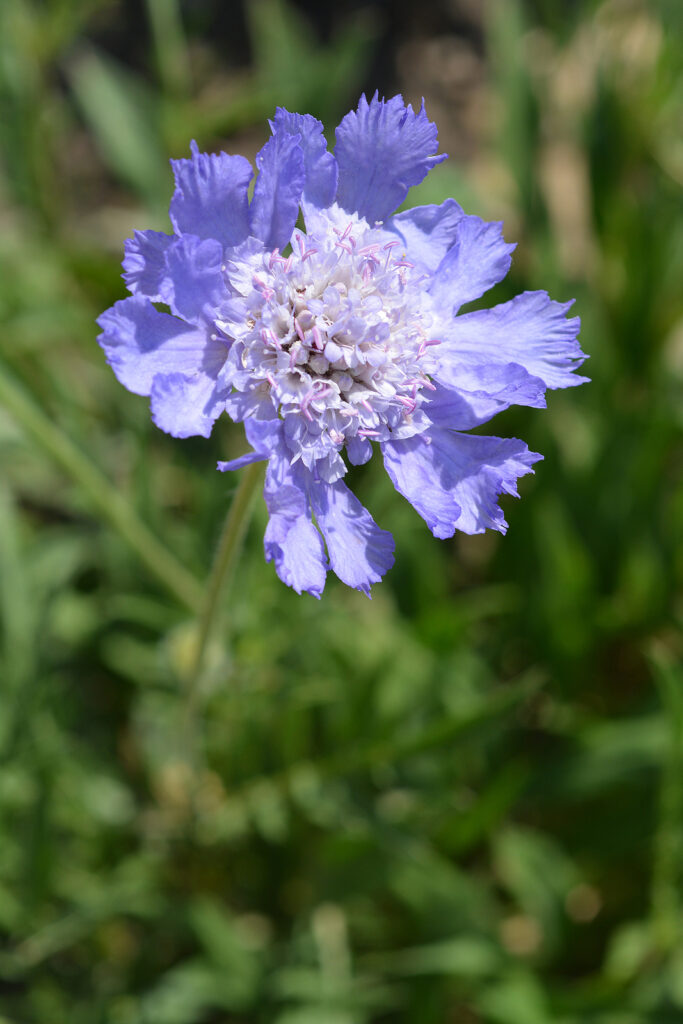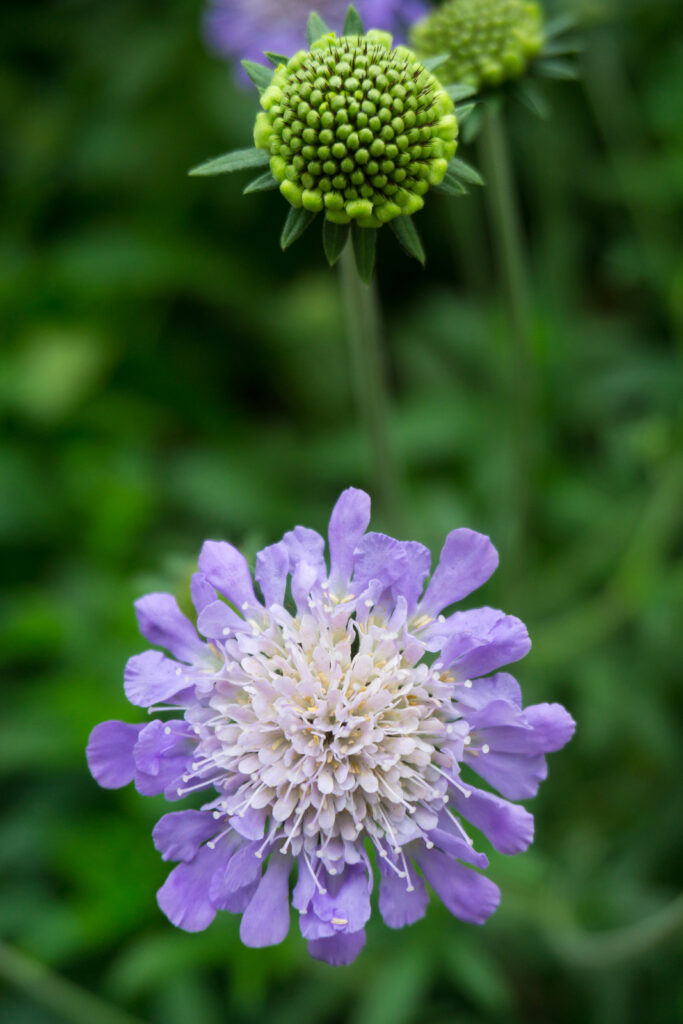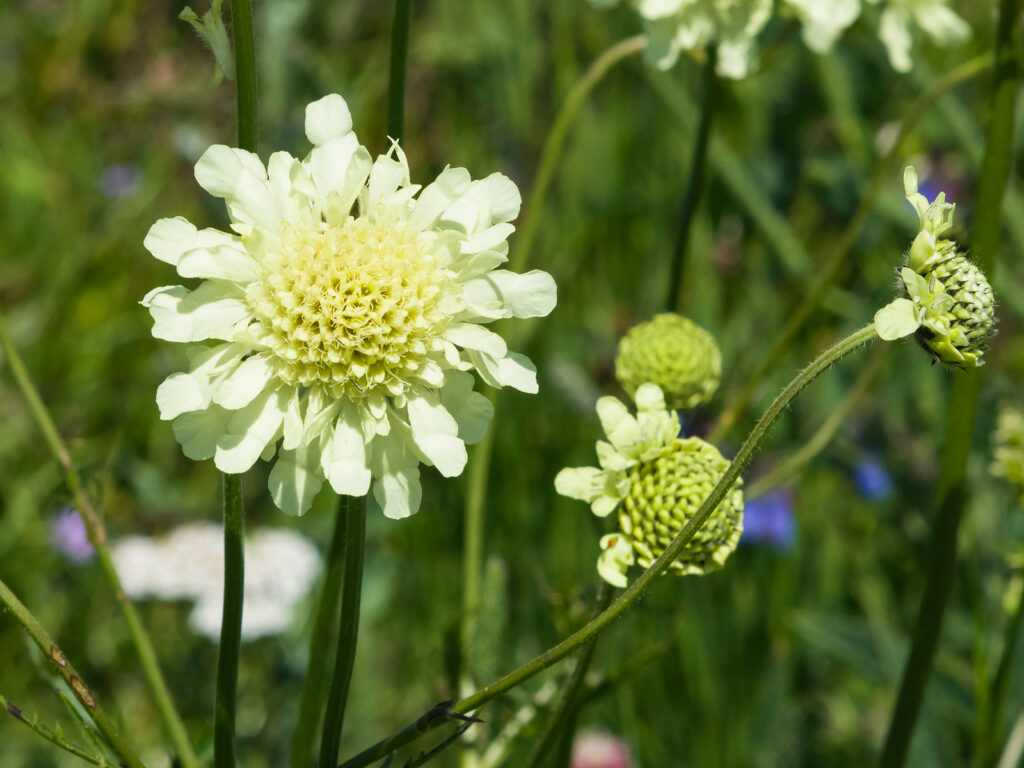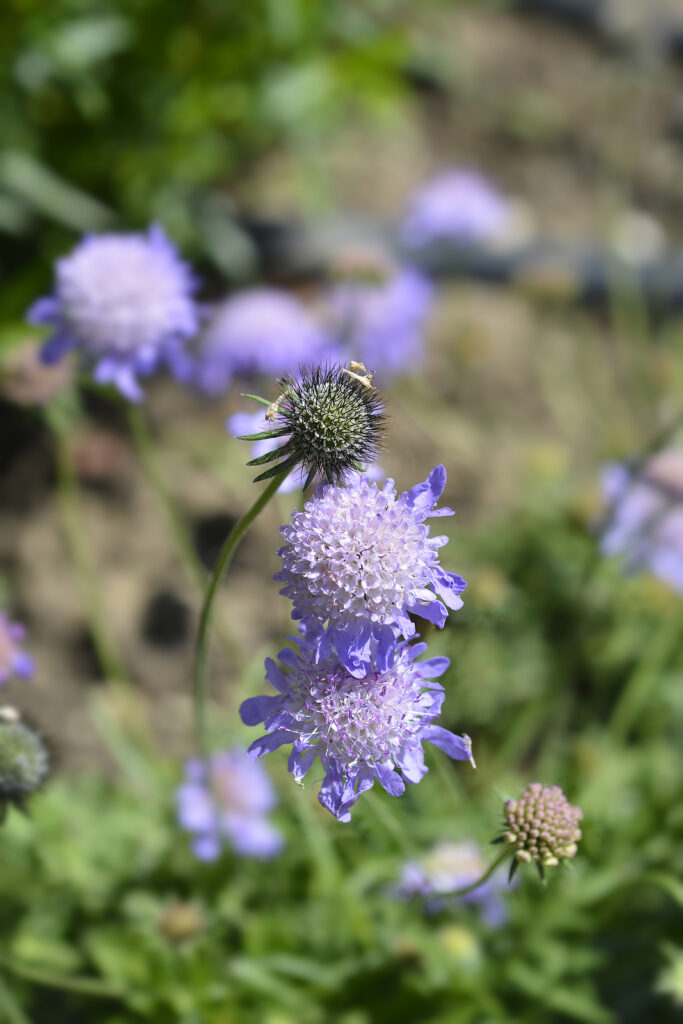Scabiosa–commonly called pincushion flower–bears small rounded usually lavender-blue flowers that resemble pincushions atop wiry stems. Pincushion flower blooms in mid and late summer. It is a clump-forming perennial with lance-shaped, gray-green basal leaves.
Scabiosa flowers can be single or double. They have small central florets that form the “pincushion” surrounded by larger petal-like florets. The leaves can be lobed or deeply cut in a featherlike fashion.
Scabiosa is a good choice in beds, borders, and massed plantings. Plant three or more plants together in a border for impact. Some cultivars may need support–especially when grown as annuals.
There are about 80 species in the Scabiosa genus.
Flower Garden Success Products at Amazon:
- Wildflower Seed Mix Attracts Hummingbirds and Butterflies
- Eden Brothers All Perennial Seed Mix
- 10 pcs Stainless Steel Garden Hand Tool Set
- Gorilla Cart 4 Cu. Ft, 300-pound Capacity
- Neem Bliss 100-% Cold Pressed Neem Oil
- Safer Brand Insect Killing Soap

Get to know Scabiosa
- Plant type: Perennial or half-hardy annual
- Growing Zones and range: All zones as an annual, Zones 3 to 8 as a perennial
- Hardiness: Hardy to -35°F (-37°C); withstands cold and moderate heat
- Height and width: 12 to 24 inches tall (30-61cm); 6 to 12 inches wide (15-30cm) wide
- Foliage: Mainly basal leaves are simple and entire or lobed
- Flowers: Flattened round heads 2 to 3 inches (5-7.5cm) wide, on long stems; blooms open in whorls
- Flower colors: Pink, blue, lavender, burgundy, cream, and white
- Bloom time: Mid- and late summer
- Uses: Cut flowers, attracts butterflies, mixed borders
- Common name: Scabiosa, pincushion flower
- Botanical name: Scabiosa atropurpurea, S. caucasia
- Family: Dipsacaceae
- Origin: Rocky slopes of the Mediterranean region
Where to plant Scabiosa
- Grow Scabiosa in full sun in Zones 3-5; grow plants in light shade in Zones 6-7.
- Plant Scabiosa in humus-rich, moist, but well-drained soil.
- Sow seeds outdoors when temperatures are 65°F (18°C) or warmer.
- Scabiosa grows best if sown where they will grow.
Scabiosa uses and companions
- Plant tall Scabiosa cultivars in a sunny herbaceous or mixed border, or a wild garden.
- Small perennial species are ideal for rock gardens.
- Long-flowering species and cultivars can be used in containers and window boxes.
- Many varieties are good for cutting.
- Good garden companions for Scabiosa include Achillea ‘Moonshine’, Diascia, Geranium, Malva, Penstemon, Sisyrinchium striatum

When to plant Scabiosa
- Start seeds indoors 4 to 5 weeks before the last frost in spring.
- Sow seeds outdoors after the last frost in spring. From Zone 8 and warmer seeds can be sown in autumn.
- Set established Scabiosa in the garden in spring after all danger of frost has passed.
Planting and spacing Scabiosa
- Sow seeds 1/8 inch deep in small pots filled with potting soil. Keep seeds at 65°F (18°C) or slightly warmer until seeds germinate in 7 to 14 days.
- Space Scabiosa are 6 to 12 inches (15-30cm) apart when they are 4 inches (10cm) tall. They can be transplanted at that stage.
How to water and feed Scabiosa
- Scabiosa need abundant moisture; keep the soil evenly moist.
- Fertilize pin cushion flowers every 4 to 6 weeks or work a slow-release fertilizer into the soil in spring.
Good Products for Seed Starting Success at Amazon:
- Jump Start Germination Station w/Heat Mat Tray, 72-Cell Pack, Dome
- Espoma Seed Starting Mix
- 200 Count- Jiffy 7 Peat Soil Seed Starting Plugs
- Seed Starter Kit with Humidity Dome (120 Cells Total Tray)
- AgrobriteT5 Fluorescent, 2-Foot, Grow Light System
Scabiosa care
- Mulch around pin cushion flowers to conserve soil moisture.
- Water plants whenever the soil starts to dry out and when they wilt in hot weather.
- Fertilize plants lightly at planting time and during active growth
- Trim off spent flowers to promote new blooms.
- Protect plants in winter by mulching around the crowns with chopped leaves or another lightweight mulch such as salt hay. Pull back the mulch after the last frost so new leaves can emerge.
- Slugs sometimes attack pin cushion flowers.

Scabiosa propagation
- Start seed indoors under fluorescent lights; seeds will germinate in 7 to 14 days at 65°F (18°C).
- Keep seedlings in a bright window or a few inches from a fluorescent light. when plants are 4 inches (10cm) tall move them outdoors or into larger pots.
- Set plants outdoors after all danger of frost has passed, after hardening them off for 3 or 4 days.
- Pincushion flower can be propagated by division; divide an established clump into two new clumps if the old one is overcrowded; divide the pincushion flower in spring.

Scabiosa varieties to grow
- Scabiosa atropurpurea (sweet scabiosa) is a half-hardy annual; cultivars include ‘Blue Moon’ and ‘Nana’; ‘Butterfly Blue’ is a dwarf that grows 6-12 inches (15-30cm) tall and is heat tolerant.
- Scabiosa caucasica is a bushy perennial that grows to 24 inches (61cm); cultivars include ‘Alba’ and ‘Blue Perfection’.
- Scabiosa columbaria is a dwarf Scabiosa that grows from 6-12 inches (15-30cm) tall,
- Scabiosa ochroleuca, commonly called cream pincushion flower, has creamy yellow flower heads.
- Scabiosa stellata is an annual with spherical light blue or white flowers and grows to 18 inches tall.
Scabiosa frequently asked questions
Q: When can I sow Scabiosa seeds?
A: Start Scabiosa seeds indoors 6 to 8 weeks before the last frost in spring for transplanting into the garden just after the last frost. Sow Scabiosa outdoors after all danger of frost has passed.
Q: What is the best care for Scabiosa?
A: Plant Scabiosa in full sun in soil that is loose and amended with aged compost or planting mix. Fertilize Scabiosa monthly with soluble plant food. Water when dry but do not overwater. Be sure not to wet the foliage which can result in diseases.
Q: My pincushion flower stems did not grow straight. What can I do?
A: Tall pincushion flowers need to be staked. Plant them in masses so that stakes will not be visible.















